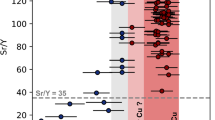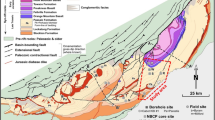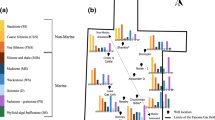Abstract
Derivative and volatility attributes calculated for well-log versus depth sequences extract characteristics that can be usefully exploited by automated machine-learning (ML) lithofacies classification models. That information is valuable for wellbores that have a restricted suite of recorded well logs and no cores recovered, limiting the detailed geological information available. In this study, a ten-well dataset, calibrated with core information, from the large Panoma gas Field (Kansas, U.S.A), with a suite of five well logs through a complex Lower Permian carbonate and siliciclastic lithofacies sequence is evaluated with seven ML models. Detailed cross-validation. feature selection analysis identifies that the volatility of the neutron-density porosity log added to the five recorded well logs improves lithofacies classification performance with this dataset without recourse to geological input. The support vector classifier (SVC) provides the most accurate facies class prediction of the ML models tested, achieving prediction accuracy of 61.2% with this six feature dataset. However, the addition of calculated facies boundary influence attributes further improves the SVC’s facies class prediction accuracy to 77.2% (weighted average F1 score of 0,7620) for data unseen by the trained model. Training, validation and unseen data testing of the ML models reveals that the SVC model is less prone to overfitting than the other ML models evaluated with the attribute enhanced datasets. In the absence of detailed geological inputs, such attribute-enhanced well-log datasets can be used to reliably locate target reservoir lithofacies, such as high productivity zones associated with high porosity and permeability, with automated ML models.












Similar content being viewed by others
References
Abbas MA, Al-Mudhafar WJ (2021) Lithofacies classification of carbonate reservoirs using advanced machine learning: a case study from a Southern Iraqi oil field. Offshore Technology Conference, Virtual and Houston, Texas, U.S.A, August 2019. https://doi.org/10.4043/31114-MS
Agrawal R, Malik A, Samuel R, Saxena A (2022) Real-Time Prediction of litho-facies from drilling data using an artificial neural network: a comparative field data study with optimizing algorithms. J Energy Res Technol 144:043003. https://doi.org/10.1115/1.4051573
Al-Mudhafar WJ (2017) Integrating well log interpretations for lithofacies classification and permeability modeling through advanced machine learning algorithms. J Petrol Explor Prod Technol 7:1023–1033. https://doi.org/10.1007/s13202-017-0360-0
Al-Mudhafar WJ, Al Lawe EM, Noshi CI (2019) Clustering analysis for improved characterization of carbonate reservoirs in a Southern Iraqi oil field. Offshore Technology Conference, Houston, Texas, U.S.A. May 2019. https://doi.org/10.4043/29269-MS
Al-Mudhafar WJ (2020). Advanced supervised machine learning algorithms for efficient electrofacies classification of a carbonate reservoir in a giant Southern Iraqi oil field. Offshore Technology Conference, Houston, Texas, U.S.A. May 2020. https://doi.org/10.4043/30906-MS
Ameur-Zaimeche O, Aziez Z, Heddam S, Kechiched R (2020) Lithofacies prediction in non-cored wells from the Sif Fatima oil field (Berkine basin, southern Algeria): a comparative study of multilayer perceptron neural network and cluster analysis-based approaches. J Afr Earth Sci 166:103826. https://doi.org/10.1016/j.jafrearsci.2020.103826
Avseth P, Mukerji T (2002) Seismic lithofacies classification from well logs using statistical rock physics. Petrophysics 43(02):70–81. https://doi.org/10.2118/170748-MS
Bestagini P, Lipari V, Tubaro S (2017) A machine learning approach to facies classification using well logs. Proceedings of the SEG International Exposition and 87th Annual Meeting. 2137. https://doi.org/10.1190/segam2017-17729805.1
Bressan TS, Kehl de Souza M, Girelli TJ, Junior FC (2020) Evaluation of machine learning methods for lithology classification using geophysical data. Comput Geosci 139:104475. https://doi.org/10.1016/j.cageo.2020.104475
Busch J, Fortney W, Berry LN (1987) Determination of lithology from well logs by statistical analysis. SPE Form Eval 2:412–418. https://doi.org/10.2118/14301-PA
Byrnes AP, Dubois MK, Magnuson M (2001) Western tight gas carbonates: comparison of Council Grove Group, Panoma Field, southwest Kansas, and western low permeability gas sands. Am Assoc Petrol Geol Annu Convention 10:A31
Cant DJ (1992) Subsurface facies analysis. In: Walker RG, James NP, editors. Facies models, response to sea level changes. Geol Assoc Canada, pp 27–45
Dell’Aversana P (2019) Comparison of different machine learning algorithms for lithofacies classification from well logs. Bollettino di Geofisica Teorica ed Applicata 60(1):69–80. https://doi.org/10.4430/bgta0256
Dubois MK, Bohling GC, Chakrabarti S (2007a) Comparison of four approaches to a rock facies classification problem. Comput Geosci 33:599–617
Dubois MK, Byrnes AP, Bohling GC, Seals SC, Doveton JH (2003) Statistically-based lithofacies predictions for 3-D reservoir modeling: examples from the Panoma (Council Grove) Field, Hugoton Embayment, Southwest Kansas. In: Proceedings of the American Association of Petroleum Geologists annual convention 12:A44
Dubois MK, Byrnes AP, Bhattacharya S, Bohling GC, Doveton JH, Barba RE (2007b) Hugoton Asset Management Project (HAMP): Hugoton Geomodel Final Report. Kansas Geological Society Open File Report 2007b–6. http://www.kgs.ku.edu/PRS/publication/2007/OFR07_06/index.html. [Accessed 28th February 2022]
Fadokun DO, Oshilike IB, Onyekonwu MO (2020) Supervised and unsupervised machine learning approach in facies prediction. SPE-203726-MS. Nigeria Annual International Conference and (Virtual) Exhibition. 2020. https://doi.org/10.2118/203726-MS
Faga AT, Oyeneyin BM (2000) Effects of diagenesis on neural-network grain-size prediction. SPE-60305-MS. Rocky Mountain Regional/Low-Permeability Reservoirs Symposium and Exhibition, Denver, Colorado, March 2000. https://doi.org/10.2118/60305-MS
Farzi R, Bolandi V (2016) Estimation of organic facies using ensemble methods in comparison with conventional intelligent approaches: a case study of the South Pars Gas Field, Persian Gulf. Iran Model Earth Syst Environ 2:105. https://doi.org/10.1007/s40808-016-0165-z
Goncalves CA, Harvey PK, Lovell MA (1995) Application of a multilayer neural network and statistical techniques in formation characterization. In: SPWLA 36th annual logging symposium, Paris, 26–29 Jun, Society of Petrophysicists and Well Log Analysts, Houston (U.S.A.) 12 pages
Gwinner DM, Laude LS, Olmos JL, Quirein JA, Reimer LJ (1991) Improved Reservoir Characterization By Integration Of Petrophysics, Geology And Core Analysis: An Example From The Hugoton Field, Kansas. SPWLA 32nd Annual Logging Symposium, Midland, Texas, June 1991.Paper SPWLA-1991-TT
Hall B (2016a) Facies Classification Using Machine Learning. Lead Edge 35(10):906–909. https://doi.org/10.1190/tle35100906.1
Hall M, Hall B (2017) Distributed collaborative prediction: results of the machine learning contest. Leading Edge 36(3):267–269. https://doi.org/10.1190/tle36030267.1
Hall B (2016b) Facies classification machine learning contest dataset. https://github.com/brendonhall/facies_classification/find/master. [Accessed 28th February, 2022]
Halotel J, Demyanov V, Gardiner A (2020) Value of geologically derived features in machine learning facies classification. Math Geosci 52:5–29. https://doi.org/10.1007/s11004-019-09838-0
Hemsell CC (1939) Geology of Hugoton Gas Field of Southwestern Kansas. AAPG Bull 23(7):1054–1067. https://doi.org/10.1306/3D9330DA-16B1-11D7-8645000102C1865D
Hossein TM, Watada J, Aziz IA, Hermana M (2020) Machine learning in electrofacies classification and subsurface lithology interpretation: a rough set theory approach. Appl Sci 10:5940. https://doi.org/10.3390/app10175940
Hurst A (1990) Natural gamma-ray spectroscopy in hydrocarbon bearing sandstones from the Norwegian continental shelf, in Geological Applications of Wireline Logs. Geological Society, London, Special Publication, eds. Hurst A, Lovell MA, Morton AC 48:211–222
Ippolito M, Ferguson J, Jenson F (2021) Improving facies prediction by combining supervised and unsupervised learning methods. J Petrol Sci Eng 200:108300. https://doi.org/10.1016/j.petrol.2020.108300
Kesslar L, Sachs SD (1995) Depositional setting and sequence stratigraphic implications of the Upper Sinemurian (Lower Jurassic) sandstone interval, North Celtic Sea/St George’s Channel Basins, offshore Ireland. Geol Soc Lond Spec Publ 93(1):171–92. https://doi.org/10.1144/GSL.SP.1995.093.01.13
Krumbein WC, Sloss LL (1951) Stratigraphy and sedimentation. W.H.Freeman and Co, San Francisco (USA) 497 pages. https://doi.org/10.1002/gj.3350010110
SciKit Learn (2022a) Supervised and unsupervised machine learning models in Python. 2022a. https://scikit-learn.org/stable/ [Accessed 28th February 2022a].
SciKit Learn (2022b) GridSearchCV: Exhaustive search over specified parameter values for an estimator in Python. https://scikit-learn.org/stable/modules/generated/sklearn.model_selection.GridSearchCV.html. [Accessed 28th February 2022b].
SciKit Learn (2022c) Bayesian optimization of hyperparameters in Python.. https://scikit-optimize.github.io/stable/modules/generated/skopt.BayesSearchCV.html [Accessed 28th February 2022c].
SciKit Learn (2022d) Cross-validation: evaluating estimator performance.https://scikit-learn.org/stable/modules/cross_validation.html[Accessed 28th February 2022d].
Lee SH, Datta-Gupta A (1999) Electrofacies characterization and permeability predictions in carbonate reservoirs: role of multivariate analysis and nonparametric regression. In: SPE annual technical conference and exhibition (3–6 October), Houston, Texas. https://doi.org/10.2118/56658-MS
Mandal PP, Rezaee R (2019) Facies classification with different machine learning algorithm – An efficient artificial intelligence technique for improved classification. ASEG Extended Abstracts 1:1–6. https://doi.org/10.1080/22020586.2019.12072918
Merembayev T, Kurmangaliyev D, Bekbauov B, Amanbek YA (2021) Comparison of machine learning algorithms in predicting lithofacies: Case studies from Norway and Kazakhstan. Energies 14:1896. https://doi.org/10.3390/en14071896
Olson TM, Babcock JA, Prasad KVK, Boughton SD, Wagner PD, Franklin MH, Thompson KA (1997) Reservoir characterization of the giant Hugoton gas field, Kansas. AAPG Bull 81(11):1785–1803
Potratz GL, Canchumuni SWA, Castro JDB, Potratz J, Pacheco MAC (2021) Automatic Lithofacies Classification with t-SNE and K-Nearest Neighbors Algorithm. Anuário Do Instituto De Geociências 44:35024. https://doi.org/10.11137/2021_44_35024
Puskarczyk E (2019) Artificial neural networks as a tool for pattern recognition and electrofacies analysis in Polish palaeozoic shale gas formations. Acta Geophys 67:1991–2003. https://doi.org/10.1007/s11600-019-00359-2
Reverdy X, Argaud M, Walgenwitz F (1983) Minerological analysis required for log interpretation in complex lithologies. Paper H, Transactions of the SPWLA 8th European Symposium
Rider MH (1990) Gamma-ray log shape used as a facies indicator: critical analysis of an oversimplified methodology. Geol Soc Lond Spec Publ 48:27–37. https://doi.org/10.1144/GSL.SP.1990.048.01.04
Rogers SJ, Fang J, Karr C, Stanley D (1992) Determination of lithology from well logs using a neural network (1). AAPG Bull 76:731–739
Russell WL (1944) The total gamma ray activity of sedimentary rocks as indicated by Geiger counter determinations. Geophysics 9(2):180–216. https://doi.org/10.1190/1.1445076
Sarkar S, Majundar C (2020) A comparative analysis of supervised classification algorithms for lithofacies characterization. EAGE Digitalization Conference and Exhibition, Nov 2020. European Association of Geoscientists & Engineers 1–5. https://doi.org/10.3997/2214-4609.202032090
Scholle PA, Spearing D (1982) Sandstone depositional environments. American Association of Petroleum Geologists Memoir 31:410 pages. ISBN: 9780891813071
Selley RC (1978) Concepts and Methods of Subsurface Facies Analysis. American Association of Petroleum Geologists Education Course Notes Series #9. https://doi.org/10.1306/CE9397
Shashank S, Mahapatra MP (2018) Boosting rock facies prediction: weighted ensemble of machine learning classifiers. Abu Dhabi International Petroleum Exhibition & Conference, Abu Dhabi, UAE. SPE-192930-MS. https://doi.org/10.2118/192930-MS
Tang H, White C, Zeng X, Gani MR, Bhattacharya JP (2004) Comparison of multivariate statistical algorithms for wireline log facies classification. AAPG Ann Meet Abstr 88:13
Tran TV, Ngo HH, Hoang SK, Tran HN, Lambiase JL (2020) Depositional Facies Prediction Using Artificial Intelligence to Improve Reservoir Characterization in a Mature Field of Nam Con Son Basin, Offshore Vietnam. Offshore Technology Conference Asia, Kuala Lumpur, Malaysia, November 2020 OTC-30086-MS. https://doi.org/10.4043/30086-MS
Wood DA (2019) Lithofacies and stratigraphy prediction methodology exploiting an optimized nearest-neighbour algorithm to mine well-log data. Mar Pet Geol 110:347–367. https://doi.org/10.1016/j.marpetgeo.2019.07.026
Wood DA (2020) Bakken stratigraphic and type well log learning network for transparent prediction and rigorous data mining. Nat Resour Res 29(2):1329–1349. https://doi.org/10.1007/s11053-019-09525-1
Wood DA (2022) Gamma-ray log derivative and volatility attributes assist facies characterization in clastic sedimentary sequences for formulaic and machine learning analysis. Adv Geoenergy Res 6(1):69–85. https://doi.org/10.46690/ager.2022.01.06
Wrona T, Pan I, Gawthorpe RL, Fossen H (2018) Seismic facies analysis using machine learning. Geophysics 83(5):O83–O95. https://doi.org/10.1190/GEO2017-0595.1
Xie Y, Zhu C, Lu Y, Zhu Z (2019) Towards optimization of boosting models for formation lithology identification. Math Problems Eng 5309852. https://doi.org/10.1155/2019/5309852
Funding
No funding was received for this study.
Author information
Authors and Affiliations
Corresponding author
Ethics declarations
Conflicts of interest
The author has no conflicts of interest associated with this study.
Additional information
Communicated by H. Babaie
Publisher's note
Springer Nature remains neutral with regard to jurisdictional claims in published maps and institutional affiliations.
Highlights
• Well-log derivative, volatility and boundary attributes aid complex lithology facies classification where limited geological data is available
• Support vector classifier is able to avoid overfitting complex attribute-enhanced dataset making it more generalizable to unseen data than other machine learning models evaluated
• Neutron-density log volatility combined with boundary influence attributes form an effective facies discriminator for complex carbonate / siliciclastic sequences.
Appendix A. Metrics used to predict lithofacies classification performance
Appendix A. Metrics used to predict lithofacies classification performance
A combination of traditional regression-type error metrics and classification accuracy metrics are used in this study to assess the performance of machine-learning models in predicting complex limestone lithofacies. These are displayed in Fig. 13.
13.
Rights and permissions
About this article
Cite this article
Wood, D.A. Carbonate / siliciclastic lithofacies classification aided by well-log derivative, volatility and sequence boundary attributes combined with machine learning. Earth Sci Inform 15, 1699–1721 (2022). https://doi.org/10.1007/s12145-022-00829-0
Received:
Accepted:
Published:
Issue Date:
DOI: https://doi.org/10.1007/s12145-022-00829-0





